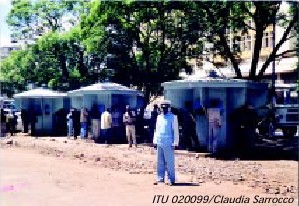ITU case study on Internet diffusion in Ethiopia
The Federal Democratic Republic of
Ethiopia is one of the oldest countries in Africa. In 2001, the country had some
343 000 fixed lines in service, and teledensity reached 0.54 per cent. The
following is a summary based on the field research and case study (see www.itu.int/osg/spu/casestudies
) carried out by ITU and the Commonwealth
Telecommunications Organisation in March 2002.
ETC — still a monopoly
In the wake of market reforms to
develop a more efficient and reliable telecommunication service, the
Government of Ethiopia created the Ethiopian Telecommunications Agency as an
independent national regulatory authority in 1996. Yet, all telecommunication
services (fixed, mobile and Internet) are still under the monopoly of the
incumbent operator, the Ethiopian Telecommunications Corporation (ETC).
The Government’s plans are still on course to partially
privatize ETC to allow the participation of a strategic investor. This should
bring new funding and new management techniques and skills to ETC.
 Poor infrastructure, limited services and unsatisfied
demand Poor infrastructure, limited services and unsatisfied
demand
With a national switching capacity of
550 000 lines, of which only 61 per cent are in use, the growing demand for
telecommunication services is not being met: the fixed-line waiting list stood
at 153 000 in February 2002, or an average waiting time of around eight years.
Mobile services are not faring well either, despite growing
demand — the waiting list is over 40 000 and there are no plans to allow
another operator onto the market in the near future. Ethiopia has some 28 000
mobile subscribers. New subscriptions were suspended in 2001, two years after
the launch of the service, when the maximum capacity of the system was attained.
Only basic voice tele-communications are provided (with no international
roaming), and are relatively affordable. A mobile-to-mobile call costs ETB 0.75
(around one third of a US cent) a minute. But this is failing to generate
revenue to expand the network.
Internet policy
Ethiopia had full Internet access in
1997, when ETC started providing Internet services using a 256 kbit/s
international satellite link. Today, a 2-Mbit/s symmetric international link is
provided by France Telecom. The number of Internet subscribers reached
6000 in 2001, for a total of 30 000 estimated Internet users, the large majority
of whom are located in the capital city, Addis Ababa. The average cost of
Internet dial-up services is heavily influenced by the high subscription fees
charged by ETC. A basic private subscription with 8 hours of access costs USD
19, and USD 4 for each extra hour. Telephone charges however, are not
particularly burdensome, with the standard local tariff applied throughout the
country.
Conclusion
For
further information on Policy and Strategy Trends,
please contact:
ITU Strategy and Policy Unit,
International Telecommunication Union,
Place
des Nations,
CH-1211 Geneva 20 (Switzerland).
Fax: +41 22 730 6453.
E-mail: spumail@itu.int.
Website: www.itu.int/osg/spu/ |
Aside from Ethiopia’s low level of
economic development, Internet diffusion has been constrained by ETC’s
monopoly and the lack of a clear policy on value-added services such as Web
design, site hosting or cybercafés. The institution of a regulatory
authority and the plan to partially privatize ETC are important steps towards an
open market. However, care should be taken to avoid a simple shift from a public
monopoly to a private one, which can become even more difficult to control —
especially if backed by a large foreign partner.
The licensing of new mobile operators, Internet service
providers, cybercafés and call centres would provide impetus for the provision
of much-needed value-added services. This would go some way towards
demonstrating the market benefits of liberalization, and the improvements this
will bring for users.
|
 Poor infrastructure, limited services and unsatisfied
demand
Poor infrastructure, limited services and unsatisfied
demand